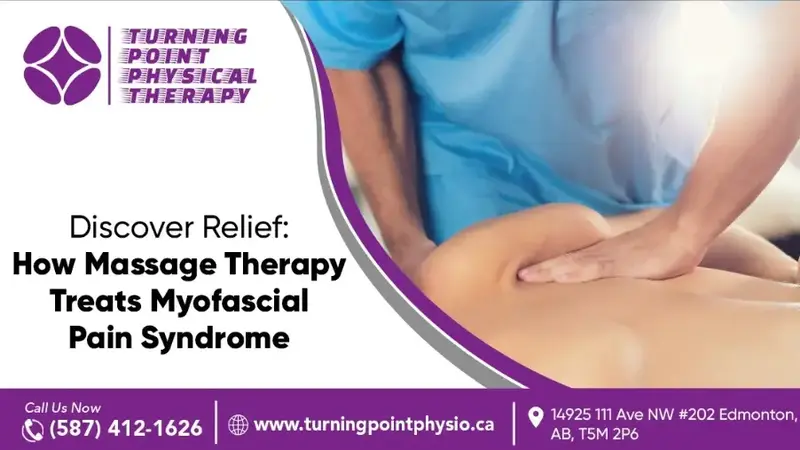Myofascial Pain Syndrome (MPS) is a chronic condition characterized by deep, aching pain in the muscles. The pain stems from trigger points—tight bands of muscle fibers that can be painful when touched. These trigger points can cause discomfort in seemingly unrelated parts of the body, making MPS a perplexing and challenging condition to manage. Fortunately, massage therapy in Edmonton offers a comprehensive solution through massage for myofascial pain syndrome, which has proven to alleviate the symptoms of MPS.
Understanding Myofascial Pain Syndrome
Myofascial Pain Syndrome is muscle pain; it involves a complex relationship between the muscles and the fascia, the connective tissue surrounding them. This condition is often caused by muscle overuse, injury, or stress, leading to the formation of trigger points. These trigger points refer to pain at the trigger point. Common symptoms of MPS include:
– Persistent, profound, aching pain in muscles
– Pain that worsens with activity or stress
– Tender knots in muscles
– Difficulty sleeping due to pain
– Reduced range of motion
The Role of Massage Therapy in Treating Myofascial Pain Syndrome (MPS)
Massage therapy in Edmonton is an effective treatment for Myofascial Pain Syndrome (MPS). Massage therapy helps manage the symptoms of those suffering from MPS. Here’s an in-depth look at how massage therapy plays a crucial role in treating MPS:
1. Trigger Point Therapy
Trigger point therapy treats hyperirritable spots within the fascia surrounding the muscles. These points, often called knots, can cause significant pain and discomfort.
– Identification: The therapist locates the trigger points through palpation and patient feedback.
– Direct Pressure: Applying sustained pressure directly on the trigger point helps release the tight muscle fibres, reducing pain and tension.
– Stretching: After releasing the trigger point, gentle stretching of the muscle helps maintain flexibility and prevent the recurrence of tightness.
2. Myofascial Release
Myofascial release aims to alleviate pain and restore motion by targeting the fascial system. This technique involves:
– Sustained Pressure: Applying gentle, sustained pressure to the fascia helps to release restrictions and improve tissue elasticity.
– Movement Integration: The therapist may incorporate slow, guided movements to enhance the release process and restore standard movement patterns.
– Holistic Approach: Myofascial release considers the fascia’s interconnected nature, treating localized pain and addressing compensatory patterns in the body.
3. Deep Tissue Massage
Deep tissue massage is effective for chronic muscle tension and persistent trigger points. It involves:
– Deeper Pressure: The therapist uses slower strokes and more intense pressure to target the deeper muscle and connective tissue layers.
– Breaking Down Adhesions: This technique helps break down adhesions (bands of painful, rigid tissue), disrupt circulation, and cause pain.
– Enhancing Blood Flow: Increased blood flow helps to flush out toxins, bring in nutrients, and promote healing in the affected areas.
4. Sports Massage
Sports massage is a specialized therapy that integrates various techniques to address muscle tightness and enhance athletic performance. It combines stretching and deep tissue work to target specific muscle groups affected by repetitive strain injuries common in athletes. By applying deep pressure and focused movements, sports massage alleviates tension, improves flexibility, and promotes quicker recovery from muscle fatigue and injury. This therapy not only aids in relieving Myofascial Pain Syndrome (MPS) but also enhances overall muscle function and performance.
5. Cross-Fiber Friction
Cross-fiber friction is a massage technique that involves applying firm pressure perpendicular to the direction of muscle fibers. It effectively breaks down adhesions and scar tissue that can form due to overuse or injury. By promoting better circulation and flexibility within muscle fibers, cross-fiber friction helps restore proper muscle function and range of motion. It is commonly used in rehabilitation settings to complement other therapeutic massage approaches for conditions like MPS, facilitating improved muscle health and reducing pain.
6. Neuromuscular Therapy (NMT)
Neuromuscular therapy identifies and targets trigger points—areas of localized muscle tension that can cause referred pain and discomfort. By applying precise pressure and releasing these trigger points, NMT aims to restore proper neuromuscular function and alleviate pain associated with MPS. This technique combines static pressure and rhythmic manipulation to address muscle imbalances and improve muscle tone and function.
7. Percussive Massage
Percussive massage involves rhythmic tapping or percussion movements applied to the muscles using various techniques and tools. This therapy stimulates circulation, enhances lymphatic drainage, and promotes muscle relaxation. In the context of MPS, percussive massage helps to reduce muscle stiffness, improve blood flow to affected areas, and accelerate the healing process. It relieves muscle soreness and tension, making it a valuable component of rehabilitation and recovery programs.
Massage Therapy in MPS Treatment
- Individualized Treatment: Each person with myofascial pain syndrome may respond differently to massage therapy. A qualified massage therapist will tailor the treatment to the individual’s needs and pain patterns.
- Frequency of Sessions: Massage therapy sessions may vary depending on the severity of MPS and individual response to treatment. More frequent sessions may be needed, followed by maintenance sessions to manage symptoms.
- Combined Approach: Massage therapy merges with other treatments for MPS, such as physical therapy, stretching exercises, and pain management strategies.
Journey to Relief From Myofascial Pain Syndrome
Effective treatment for Myofascial Pain Syndrome (MPS) is within reach. Massage therapy in Edmonton offers a path to relief, helping patients regain their quality of life. If you or a loved one is struggling with MPS, consider exploring the benefits of massage therapy. If you or your loved ones are searching for massages near me or physio massage near me, with a dedicated team of registered massage therapists and a personalized approach to care, contact Turning Point Physical Therapy today to schedule a consultation and learn more about how massage therapy can help you manage Myofascial Pain Syndrome and reclaim your life.
